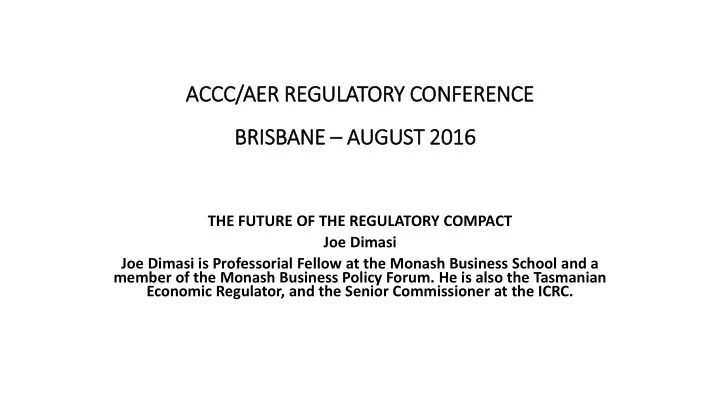

ACCC/AER REGULATORY CONFERENCE ISBANE – AUGUST 2016 BRIS THE FUTURE OF THE REGULATORY COMPACT Joe Dimasi Joe Dimasi is Professorial Fellow at the Monash Business School and a member of the Monash Business Policy Forum. He is also the Tasmanian Economic Regulator, and the Senior Commissioner at the ICRC.
THE FUTURE OF THE REGULATORY COMPACT • The issue here is the degree of certainty that service providers have from the regulatory system to recover the cost of their prudent investment. • My comments today will be largely about the Australian experience although the questions apply more generally.
Is Is there such a Regulatory ry Compact? • Reference to a regulatory compact seems to imply a degree of specific commitment. • may be true in some cases but less so in others. • Various pieces of legislation, rules and regulations provide guidance, sometimes very prescriptive guidance, to regulators on how they should regulate. • In Australia we have seen different regulatory approaches which reflected the specific circumstances of different sectors. • “Building Block” which is essentially a cost of service approach • Total Service Long Run Incremental Cost (Telecoms) • Price Caps (Early regulation of airports)
REGULATORY APPROACH IN IN VARIOUS SECTORS • Energy Networks – prudency test and upfront certainty • In the energy sector in the mid-nineties there was little expectation of technological innovation and disruption which might threaten the market power of the networks. • Also a desire for regulatory certainty as some state governments wanted to privatise their assets. • As a result, the regulatory approach quickly moved to a cost of service type regulation (Building Block). This attempted to include incentives for greater efficiency. • A key focus was on determining a value for existing sunk assets and locking them in to the regulated asset base and rolling in prudent new investment at cost. The expectation was that the investor would be able to expect to recover that investment. • Hence the focus was on an upfront prudency test. • Attempting to establish prudency in investment has probably been the single most difficult issue faced by Australian regulators.
Telecommunications – hypothetical networks to building blo locks • By contrast in the telecommunications sector there was some expectation of technological change. The regulatory approach left open the prospect of change to the asset base. A forward looking pricing approach, TSLRIC was used. • It aimed to estimate the long run marginal cost of a service based on “best in use “technology. • Turned out to be a regulatory nightmare. Ended up debating the hypothetical value of a hypothetical network that was not actually built and would not be built that way if one was built today! • Eventually regulator and regulated gave up and moved to the Building Block approach – which tends to lock in the value of the asset base.
Have upfront prudency tests been effective? • In principle the asymmetry of information which exists between the regulator and the regulated business makes this a very difficult task for the regulator. • Difficult to generalise but the evidence indicates problems. For example, the chart below suggests that the regulatory system has not been able to constrain significant overinvestment in the networks.
Have upfront prudency tests been effective?
Have upfront prudency tests been effective? • This is also a potential issue in the NBN. • Under the Long Term Revenue Constraint Methodology capital expenditure may only be included of it meets the prudency cost condition.
The current Dilemma • We face a regulatory quandary • Regulatory approach aims to give high level of regulatory certainty • But evidence suggests not effective in ensuring prudency in investment • If regulator revisits past investment (breaches compact) and increases regulatory uncertainty with implications for returns -risks appeals • If don’t do anything prices are almost certainly inefficient and too high.
How should we deal with this going forw rward? • We need to separate the issue of regulatory uncertainty from commercial uncertainty. In a competitive market there is no guarantee of a return on or of your capital whether or not it is prudently invested. • The point of the regulatory compact is to constrain regulatory discretion and regulatory uncertainty. It is not to protect the regulatory business from commercial uncertainty. • We have a problem with existing overinvestment. • Revisiting creates regulatory uncertainty. • Regulatory certainty should be reflected in returns allowed by regulator
How Should We Deal With This Going Forward? • However, Businesses cannot, and not clear that they should be, protected from commercial uncertainty • Argument that maintaining excessively high prices leads to users moving off the network - eventually to the “death spiral?” • Death Spiral arguments may be premature but technology and falling demand will make it challenging for businesses to recover all sunk costs
How should we deal with this going forward? • Regulation needs to be clear upfront what is in the regulatory compact • More appropriate for regulated business to wear the demand risk • This implies some effective write-down but is also likely to generate better incentives for the regulated businesses • May need to rethink the approach to regulation • Is cost based regulation still appropriate in the face of technological change which may begin to change the natural monopoly characteristics of the network?
Recommend
More recommend